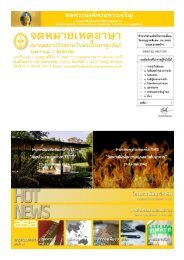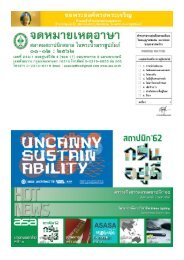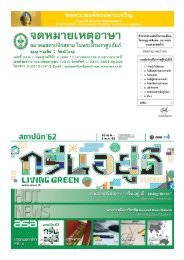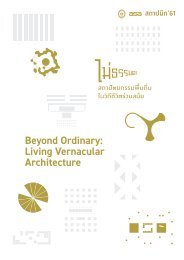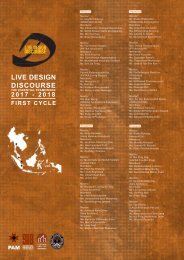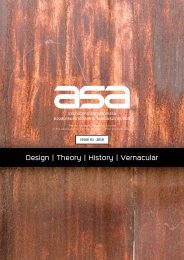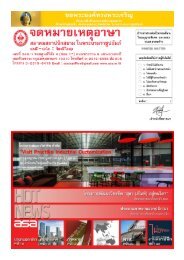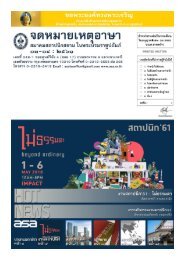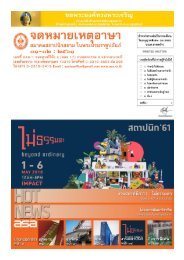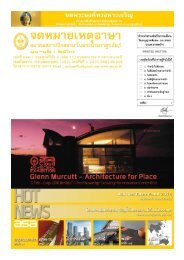ASA JOURNAL Vol.2 | 2018
You also want an ePaper? Increase the reach of your titles
YUMPU automatically turns print PDFs into web optimized ePapers that Google loves.
On ‘Material’: An Architectural Notion of the 19 th Century<br />
Pinai Sirikiatikul, Ph.D.<br />
Faculty of Architecture, Silpakorn University / p.sirikiatikul@gmail.com<br />
Abstract<br />
‘Materiality’ has recently returned to architectural discussion. This paper looks at its origin and the early development of<br />
‘material’ as a theory in 19th-century Europe. By examining and comparing the theoretical approaches to material of 3 different<br />
architectural writers - Viollet-le-Duc, Gottfried Semper and John Ruskin - the paper suggests that there is no consensus view on<br />
how material should be in architecture. It is on this basis that liberates us from an absolute definition of the term, leaving us open<br />
to a reinterpretation of the concept that it can lead to a plurality of solutions.<br />
Keywords: Material, Materiality, Viollet-le-Duc, Gottfried Semper, John Ruskin<br />
72<br />
วารสารสถาปัตยกรรมของสมาคมสถาปนิกสยาม<br />
ในพระบรมราชูปถัมภ์ Issue 02 / <strong>2018</strong><br />
The Architectural Journal of The Association of Siamese Architects<br />
under the Royal Patronage<br />
ภาพที่ 11 : รายละเอียดผนังที่ Kelling Place<br />
ที่มาภาพ: โดยผู้เขียน เมื่อปี 2010<br />
Image 4 : the Theravada Buddhist Cosmology 12<br />
แน่นอน เราอาจพิจารณาการใช้วัสดุของพายเออร์ในที่นี้ว่าเป็นการพยายามสร้างความกลมกลืน<br />
กับสภาพแวดล้อมท้องถิ่น กระทั่งมองว่าเป็นวิธีลดต้นทุนการก่อสร้างก็ได้(Cruickshank, 1999 : 42)<br />
แต่ผลงานอันวิจิตรที่เกิดขึ้นมาจากการใช้“วัตถุดิบ” ซึ่งตามความจริงแล้วก็อยู่ในที่แห่งนี้มาก่อนจะไม่มี<br />
ทางเกิดขึ้นได้เลยหากปราศจากซึ่งความตั้งใจอันแน่วแน่ของสถาปนิกและแรงงานที่ร่วมมือกันสร้างบ้าน<br />
หลังนี้ขึ้นมาอย่างพิถีพิถัน<br />
ในแง่นี้ สิ่งที่ทำให้ของไม่มีชีวิตกลายเป็นมีชีวิตขึ้นมานั้นอยู่ที่“การลงมือปฏิบัติ” ซึ่งเป็นปัจจัย<br />
แห่งการสร้างสรรค์ที่ไม่สามารถเกิดมาก่อนหรือเติมเข้ามาภายหลังได้ หากต้องเกิดขึ้นระหว่างการก่อสร้าง<br />
จนทำให้สิ่งดิบ ๆ หยาบ ๆ อย่าง หิน ดิน ทราย กลายเป็นงานสร้างสรรค์ขึ้นมาได้<br />
ใครก็ตามที่ได้เคยอ่านงานของ 3 สำนักคิดที่กล่าวมานี้จะพบว่าขณะที่พลิกหนังสือไปในแต่ละหน้าแต่ละ<br />
สำนักล้วนพูด “ถูก” ตามตรรกะที่ตนสร้างขึ้นมาทั้งสิ้น “วัสดุ” คืออะไร มีบทบาทเช่นไร มีตำแหน่งแห่งที่<br />
ในโลกนี้และสัมพันธ์กับปัจจัยสร้างสรรค์อื่น ๆ อย่างไร จริงๆ แล้วล้วนเป็นคำถามที่ถูกจัดวางในทิศทาง<br />
ที่สอดรับกับทฤษฎีที่ดำรงอยู่ก่อนแล้ว ดังนั้นเมื่อเกิดประเด็นปัญหาใหม่ๆ ขึ้น แต่ละสำนักจึงพยายาม<br />
หาทางอธิบาย “วัสดุ” ตามพื้นฐานทางปรัชญาของตนเอง ด้วยเหตุนี้ประเด็นคำถามเกี่ยวกับวัสดุจึงยัง<br />
คงเปิดกว้าง สามารถถกเถียงกันได้อีกหลายแง่มุมไม่รู้จบเพราะตราบใดที่วัฒนธรรมการก่อสร้างในสังคม<br />
ยังมีการเคลื่อนไหว แนวคิดเกี่ยวกับวัสดุของเราย่อมเปลี่ยนแปลง และแต่ละสังคมก็สามารถผลิตความ<br />
หมายของตนเอง ในลักษณะที่ไม่จำเป็นต้องเหมือนกับที่เกิดขึ้นในที่อื่น<br />
ท่ามกลางกระแสความสนใจใน “Material” ที่ได้หวนคืนมาอีกครั้ง การที่สถาปนิกในปัจจุบัน<br />
สามารถพูดถึง “วัสดุ” ได้อย่างเป็นคุ้งเป็นแคว เป็นสัญญาณบ่งชี้ว่าทฤษฎีวัสดุแห่งศตวรรษที่19 ยังคง<br />
มีอิทธิพลต่อวงการสถาปัตยกรรมมากแค่ไหน แต่ถึงกระนั้นคำถามที่ยังคงอยู่ก็คือ คุณภาพทาง<br />
สถาปัตยกรรมนั้นแท้จริงแล้ว ขึ้นอยู่กับ วัสดุที่สร้างขึ้น หรือจริง ๆ แล้ว ทั้งสองเป็นอิสระจากกัน<br />
คำถามนี้จะยังคงอยู่ต่อไป<br />
Pite: ‘in the case of Michelangelo and Wren, the one<br />
started with Classic results and the other with Italian:<br />
what should we start with?’<br />
Lethaby: ‘With materials’.<br />
A conversation between Beresford Pite and William<br />
Lethaby at Architectural Association in 1896, in a talk<br />
to the members of the Class of Design on the subject of<br />
‘The Problem of Modern Architecture’. (Anon, 1896: 307)<br />
Material is without question indispensable to architecture.<br />
Architects in every period are familiar with materials; but as<br />
a ‘theory’ of modern architecture, material has become important<br />
merely around two centuries ago. The situation<br />
changed in the 19th century as a result of the Industrial Revolution,<br />
with the advent of modern materials like iron and<br />
concrete, and demanded architects to deal with materials not<br />
just as a building medium but also as a concept. Lethaby’s<br />
reply to Pite’s question, which rejected at once the pursuit of<br />
architectural styles, is just one symptom of how essential<br />
materials were for architects in late-nineteenth-century Britain.<br />
Lethaby’s ideas about materials were in part derived<br />
from William Morris’s lecture, ‘The influence of building<br />
materials upon architecture’, given in 1891, in which Morris<br />
had formed the idea of turning to materials in order to resist<br />
the imitation of style. The problem of architecture in Morris’<br />
time was its preoccupation with past styles, and he argued that<br />
the essence of architecture lay instead in the use of the materials<br />
and the ways in which they are handled in their execution.<br />
He said, ‘the subject of Material is clearly the foundation of<br />
architecture and perhaps one would not go very far wrong if<br />
one defined architecture as the art of building suitably with<br />
suitable material’. (1902: 391) The source to which Morris<br />
turned was the certain qualities of ‘ordinary country buildings’<br />
such as simplicity, unpretentiousness and practicality: ‘the skill<br />
with which the mason has picked out his longs and his shorts,<br />
and put the thing together with really something, you must<br />
say, like rhythm and measurement (his traditional skill that<br />
was), and with the best possible results’. (1902: 394) [fig 1]<br />
The notion of paying attention to materials rather than<br />
styles was regarded by German architect Hermann Muthesius<br />
(1861-1927) as having been first advanced in English architecture:<br />
‘It was English’s achievement – and it cannot be rated<br />
highly enough – to have been the first to find an escape from<br />
this dilemma and to have done so at a time when nothing of<br />
the kind was yet stirring on the continent’. (2007, Vol.1: 101)<br />
In his book The English House, Muthesius went on to describe<br />
the pragmatism of the old craftsmanship that he witnessed<br />
many Arts and Crafts architects turning to, and then characterised<br />
the British Arts and Crafts Movement as ‘Materialism’.<br />
(2007, Vol. I: 148-149) The term ‘Materialism’, or in the original<br />
German terms ‘Materialismus’, which Muthesius used to<br />
describe a certain quality he perceived in English architecture,<br />
had been present in the German architectural context before<br />
- most evidently in the writings of Gottfried Semper and of<br />
Karl Schäfer, both theorists of whom Muthesius was a close<br />
follower. Muthesius used the term ‘Materialism’ to characterise<br />
a non-idealistic way of thinking about architecture, in<br />
opposition to the Idealist philosophy that was present in<br />
Semper. In The English House, Muthesius wrote:<br />
73<br />
วารสารสถาปัตยกรรมของสมาคมสถาปนิกสยาม<br />
ในพระบรมราชูปถัมภ์ Issue 02 / <strong>2018</strong><br />
Academic Journal of The Association of Siamese Architects<br />
under the Royal Patronage




